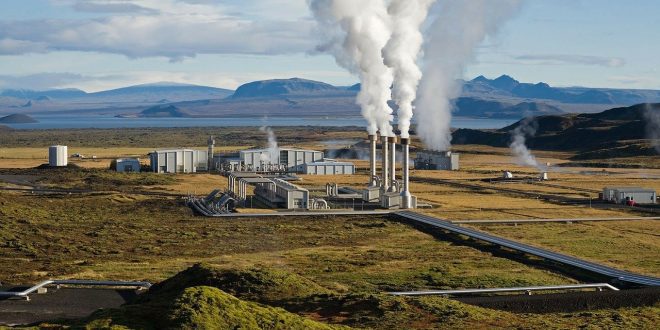When most of us think about geothermal energy, we probably conjure images of Old Faithful and bubbling geysers, creating the heat necessary to create energy. But geothermal energy is now a reliable and growing source of renewable energy as the U.S. weans itself off fossil fuels.
According to the Geothermal Energy Association (GEA), “In 2016, there were 3,567 Megawatts (MW) of geothermal power plants in operation in the United States—the most of any country—and 1,272 MW of projects in development.” Electricity generated from geothermal power plants is expected to continue its upward path as technologies improve and costs lower, both at the commercial and residential level.
What are the sources and trends in geothermal energy use at the business and household levels in the U.S.? How can geothermal energy help ease tax burdens for home and business owners? What are the trends in making geothermal energy a reliable and cost-effective method of making electricity and heating homes? Let’s read on to find out!
Geothermal Energy Sources
Geothermal energy comes from the earth’s core in the form of volcanic activity and geysers like Old Faithful. It’s important to explain that geothermal energy is both an energy source, but also a method to heat and cool buildings. In areas where there is high geothermal activity, like Iceland for example, hot water from underneath the ground is pumped directly into buildings.
Residential and Commercial Geothermal Energy
The most common household application of geothermal energy is though heap pumps. According to the U.S. Energy Information Administration: “Geothermal heat pumps (GHPs), also known as ground-source heat pumps, can heat, cool, and even supply hot water to a home by transferring heat to or from the ground. This technology has been keeping consumers comfortable for more than 50 years and can cut energy bills by up to 65% compared to traditional HVAC units.”
There are industrial uses of geothermal energy as well, mostly used in agriculture and mining. Of course, people have been using the health benefits of geothermal energy for centuries in the form of geothermal spas.
Geothermal Electricity Generation
Geothermal is one of the many renewable energy resources available to produce energy and electricity, mostly done by building power plants directly over geothermal areas and using the steam to power turbines that create electricity.
The U.S. leads the world in geothermal energy production. In 2018, there were geothermal power plants in seven states, which produced about 16.7 billion (kWh), equal to 0.4 percent of total U.S. utility-scale electricity generation.
Geothermal Energy’s Environmental Impact
The environmental impact of geothermal energy is profound and continuing to rise. As climate change and global warming become hot-button issues, research and development of more clean, renewable energy sources become more profound.
It seems that we’ve only started to harness the full potential of geothermal energy. Although the U.S. leads the world in geothermal energy production, it’s still only less than 1% of all energy consumed in the country. According to CONTRACTOR: “The Department of Energy (DOE) believes the U.S. has a minimum potential of 100,000 MW of capacity, enough to rival nuclear production in the nation. In 2018 the DOE issued some $16 million in research grants and now believes commercially viable technology could be ready by 2030”. As said earlier, technology advancements and costs for implementation could make geothermal much more available across wider areas of the U.S.
Geothermal Energy Trends
As noted above, geothermal energy is on the rise, both as a residential/commercial heating source, but also as a growing source of electricity. The financial incentives for homeowners and businesses are in the form of tax breaks from the U.S. government, especially since the Bipartisan Budget Act of 2018 brought back tax credits for geothermal heat pumps. There are other tax breaks available for business owners and homeowners in the form of credits for installing geothermal heat pumps.
Growth in geothermal energy is trending upward. According to Mordor Intelligence: “The market for geothermal energy is expected to grow significantly during the forecast period, the global cumulative geothermal energy generation capacity grew by 4.0% in 2018 when compared with 2017. Major factors driving the market include supportive government policies, drive toward cleaner energy generation, and increasing energy generation across the globe.”
Another trend in geothermal energy is its use in hybrid power systems, combining geothermal with other types of sources including photovoltaic and solar thermal power generation. A triple-hybrid plant, using all three methods mentioned, opened in 2016 in Fallon, NV. As research and development of more “hybrid geothermal” systems make them cost-efficient, growth at the residential and commercial level will become more practical for HVAC manufacturers and installers.
Geothermal Energy’s Future
Geothermal energy is nature’s escape valve from its molten core and is just a small part of an ever-growing industry that is on the cusp of ballooning. As we look for alternative energy sources other than fossil fuels, jobs we would never have expected 10 years ago, such as an Environmental Accountant, are cropping up. They, and others like them, are helping consumers find the best ways to fund renewable energy source usages such as geothermal power for buildings and other services.
Like its green energy cousins like wind and solar, geothermal is still in its infancy of providing widespread energy on a vast scale. But as the technologies used to harness these endless supplies of energy continue to advance, look for geothermal energy to be there like Old Faithful.
 Alternative Energy HQ solar power for homes, wind energy, and bio fuel issues
Alternative Energy HQ solar power for homes, wind energy, and bio fuel issues





